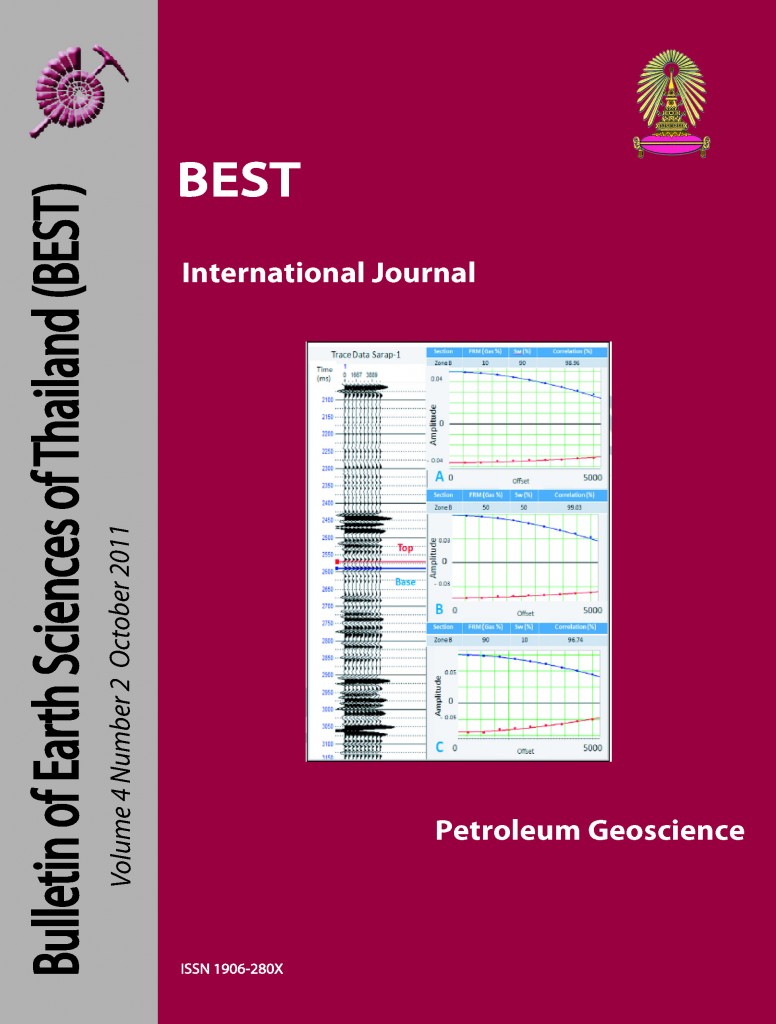Textural and Isotopic Characteristics of Tectonic Hydrothermal Breccias in Fractured Carbonates in Northeast Thailand, a Contrast with the Features of Meteoric Karst Breccias
Main Article Content
Abstract
Fractured and cemented Permian carbonates in a quarry in Chumpae region, Khon Kaen district, Northeast Thailand, reveal two fault-related hydrothermal breccia zones with distinctive features that can be used to differentiate fault-related hydrothermal breccias from meteoric karst breccias. Mesoscopically (core-observation relevant scale), hydrothermal breccias possess a set of distinctive features that include: calcite-encased sharp angular edge boundaries, rotated fitted clasts, offsetting calcite-filled fractures and calcites following (folded) bedding planes, with distinct low spectral gamma values; whereas, meteoric karst breccias edges tend to show rounded solution-enlarged boundaries, calcitic speleothems or soils passively penetrating the host rock along planes of pre-existing weakness (solutionenlarged joints and fractures or sub-cropping fault intersections with the land surface). Isotopic data, from the matrix and calcite vein cements in the hydrothermal breccias, exhibit two main burial diagenetic trends, namely; 1) A regional burial trend that is the same as the regional isotopic burial trend seen in Ratburi limestone across central and northern Thailand with increasingly negative values of oxygen and mostly positive, but decreasing values of carbon with time; and 2) Another trend or plot field shows aligned values of both oxygen and carbon that are all negative, defining a burial-related mixing of the rock matrix with a cementing fluid derived from an organic-influenced fluid source. This fluid is considered as related to pressurised fluid crossflows and entry into hydrofractured rock. This distinctive fluid/faulting event is diagenetically later than diagenetic fluids of Indosinian burial; it may relate to the stresses driving the rotation of the Khorat Plateau during the Himalayan Orogeny.
Article Details

This work is licensed under a Creative Commons Attribution-NonCommercial-NoDerivatives 4.0 International License.
Copyright © 2008 Department of Geology, Faculty of Science, Chulalongkorn University. Parts of an article can be photocopied or reproduced without prior written permission from the author(s), but due acknowledgments should be stated or cited accordingly.
References
Ampaiwan, P., 2011, Structural development of thrusts, folds and fractures in Permian Limestone quarries, Saraburi Province: implications for fractured reservoir development in NE Thailand: Master thesis Chulalongkorn University.
Baird, A., and D. Bosence, 1993, The sedimentological and diagenetic evolution of the Ratburi Limestone, Peninsular Thailand: Journal of Southeast Asian Sciences, v. 8, p. 173 -180.
Fischer, M., R. Botz, M. Schmidt, K. Rockenbauch, D. Garbe-Schönberg, J. Glodny, P. Gerling, and R. Littke, 2006, Origins of CO2 in Permian carbonate rocks (Zechstein, Ca2) of the NW-German Basin (Lower Saxony): Chemical Geology Elsevier, v. 227, p. 184 – 213.
Heward, A. P., S. Chuenbunchom, G. Mäkel, D. Marsland, and L. Spring, 2000, Nang Nuan oil field, B6/27, Gulf of Thailand: karst reservoirs of meteoric or deep-burial origin?: The Geological Society of London Petroleum Geoscience, v. 6, p. 15 – 27.
Morley, C. K., 2004, Nested strike-slip duplexes, and other evidence for LateCretaceous-Paleogene transpressional tectonics before and during India-Eurasiacollision, in Thailand, Myanmar and Malaysia: Journal of the GeologicalSociety London, v. 161, p. 799 – 812.
Morley, C. K., 2009, Evolution from an oblique subduction back-arc mobile belt to a highly oblique collisional margin: the Cenozoic tectonic development of Thailand and eastern Myanmar: Geological Society, London, Special Publications, v. 318, p. 373-403.
Susanto, W., 2010, Diagenetic and isotopic evolution recorded in calcite cements in a large Indosinian Fault Zone in Permian platform interior carbonates, North Central Thailand: Master thesis Chulalongkorn University.
Thanudamrong, S., 2011, Structural style and fracture characteristics of thrusted and folded Permian Carbonates in the Siam City Cement Company quarry, Tab Kwang, Saraburi; Analogs for fractured carbonates: Master thesis Chulalongkorn University.
Utomo, R., 2010, Fracture characterization in contrasting platform carbonate facies, Muelak and Chumphae areas central Northeast Thailand: Master thesis Chulalongkorn University.


